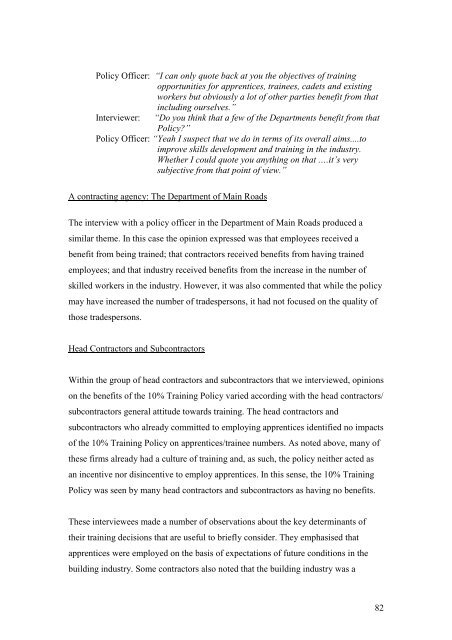Multi Outcome Construction Policy (final report)
Multi Outcome Construction Policy (final report)
Multi Outcome Construction Policy (final report)
You also want an ePaper? Increase the reach of your titles
YUMPU automatically turns print PDFs into web optimized ePapers that Google loves.
<strong>Policy</strong> Officer: “I can only quote back at you the objectives of trainingopportunities for apprentices, trainees, cadets and existingworkers but obviously a lot of other parties benefit from thatincluding ourselves.”Interviewer:“Do you think that a few of the Departments benefit from that<strong>Policy</strong>?”<strong>Policy</strong> Officer: “Yeah I suspect that we do in terms of its overall aims....toimprove skills development and training in the industry.Whether I could quote you anything on that ….it’s verysubjective from that point of view.”A contracting agency: The Department of Main RoadsThe interview with a policy officer in the Department of Main Roads produced asimilar theme. In this case the opinion expressed was that employees received abenefit from being trained; that contractors received benefits from having trainedemployees; and that industry received benefits from the increase in the number ofskilled workers in the industry. However, it was also commented that while the policymay have increased the number of tradespersons, it had not focused on the quality ofthose tradespersons.Head Contractors and SubcontractorsWithin the group of head contractors and subcontractors that we interviewed, opinionson the benefits of the 10% Training <strong>Policy</strong> varied according with the head contractors/subcontractors general attitude towards training. The head contractors andsubcontractors who already committed to employing apprentices identified no impactsof the 10% Training <strong>Policy</strong> on apprentices/trainee numbers. As noted above, many ofthese firms already had a culture of training and, as such, the policy neither acted asan incentive nor disincentive to employ apprentices. In this sense, the 10% Training<strong>Policy</strong> was seen by many head contractors and subcontractors as having no benefits.These interviewees made a number of observations about the key determinants oftheir training decisions that are useful to briefly consider. They emphasised thatapprentices were employed on the basis of expectations of future conditions in thebuilding industry. Some contractors also noted that the building industry was a82
















